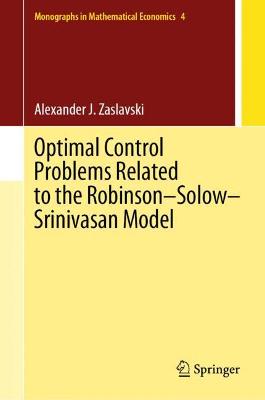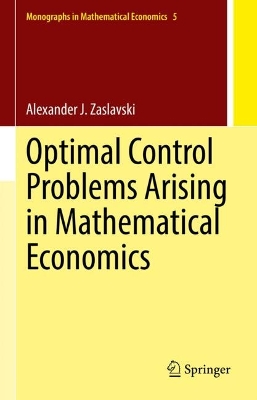Monographs in Mathematical Economics
2 primary works
Book 4
Optimal Control Problems Related to the Robinson-Solow-Srinivasan Model
by Alexander J. Zaslavski
Published 8 August 2021
This book is devoted to the study of classes of optimal control problems arising in economic growth theory, related to the Robinson-Solow-Srinivasan (RSS) model. The model was introduced in the 1960s by economists Joan Robinson, Robert Solow, and Thirukodikaval Nilakanta Srinivasan and was further studied by Robinson, Nobuo Okishio, and Joseph Stiglitz. Since then, the study of the RSS model has become an important element of economic dynamics. In this book, two large general classes of optimal control problems, both of them containing the RSS model as a particular case, are presented for study. For these two classes, a turnpike theory is developed and the existence of solutions to the corresponding infinite horizon optimal control problems is established.
The book contains 9 chapters. Chapter 1 discusses turnpike properties for some optimal control problems that are known in the literature, including problems corresponding to the RSS model. The first class of optimal control problems is studied in Chaps. 2-6. In Chap. 2, infinite horizon optimal control problems with nonautonomous optimality criteria are considered. The utility functions, which determine the optimality criterion, are nonconcave. This class of models contains the RSS model as a particular case. The stability of the turnpike phenomenon of the one-dimensional nonautonomous concave RSS model is analyzed in Chap. 3. The following chapter takes up the study of a class of autonomous nonconcave optimal control problems, a subclass of problems considered in Chap. 2. The equivalence of the turnpike property and the asymptotic turnpike property, as well as the stability of the turnpike phenomenon, is established. Turnpike conditions and the stability of the turnpike phenomenon for nonautonomous problems are examined in Chap. 5, with Chap. 6 devoted to the study of the turnpike properties for the one-dimensional nonautonomous nonconcave RSS model. The utility functions, which determine the optimality criterion, are nonconcave. The class of RSS models is identified with a complete metric space of utility functions. Using the Baire category approach, the turnpike phenomenon is shown to hold for most of the models. Chapter 7 begins the study of the second large class of autonomous optimal control problems, and turnpike conditions are established. The stability of the turnpike phenomenon for this class of problems is investigated further in Chaps. 8 and 9.
The book contains 9 chapters. Chapter 1 discusses turnpike properties for some optimal control problems that are known in the literature, including problems corresponding to the RSS model. The first class of optimal control problems is studied in Chaps. 2-6. In Chap. 2, infinite horizon optimal control problems with nonautonomous optimality criteria are considered. The utility functions, which determine the optimality criterion, are nonconcave. This class of models contains the RSS model as a particular case. The stability of the turnpike phenomenon of the one-dimensional nonautonomous concave RSS model is analyzed in Chap. 3. The following chapter takes up the study of a class of autonomous nonconcave optimal control problems, a subclass of problems considered in Chap. 2. The equivalence of the turnpike property and the asymptotic turnpike property, as well as the stability of the turnpike phenomenon, is established. Turnpike conditions and the stability of the turnpike phenomenon for nonautonomous problems are examined in Chap. 5, with Chap. 6 devoted to the study of the turnpike properties for the one-dimensional nonautonomous nonconcave RSS model. The utility functions, which determine the optimality criterion, are nonconcave. The class of RSS models is identified with a complete metric space of utility functions. Using the Baire category approach, the turnpike phenomenon is shown to hold for most of the models. Chapter 7 begins the study of the second large class of autonomous optimal control problems, and turnpike conditions are established. The stability of the turnpike phenomenon for this class of problems is investigated further in Chaps. 8 and 9.
Book 5
Optimal Control Problems Arising in Mathematical Economics
by Alexander J. Zaslavski
Published 6 August 2022
This book is devoted to the study of two large classes of discrete-time optimal control problems arising in mathematical economics. Nonautonomous optimal control problems of the first class are determined by a sequence of objective functions and sequence of constraint maps. They correspond to a general model of economic growth. We are interested in turnpike properties of approximate solutions and in the stability of the turnpike phenomenon under small perturbations of objective functions and constraint maps. The second class of autonomous optimal control problems corresponds to another general class of models of economic dynamics which includes the Robinson–Solow–Srinivasan model as a particular case.
In Chap. 1 we discuss turnpike properties for a large class of discrete-time optimal control problems studied in the literature and for the Robinson–Solow–Srinivasan model. In Chap. 2 we introduce the first class of optimal control problems and study its turnpike property. This class of problems is also discussed in Chaps. 3–6. In Chap. 3 we study the stability of the turnpike phenomenon under small perturbations of the objective functions. Analogous results for problems with discounting are considered in Chap. 4. In Chap. 5 we study the stability of the turnpike phenomenon under small perturbations of the objective functions and the constraint maps. Analogous results for problems with discounting are established in Chap. 6. The results of Chaps. 5 and 6 are new. The second class of problems is studied in Chaps. 7–9. In Chap. 7 we study the turnpike properties. The stability of the turnpike phenomenon under small perturbations of the objective functions is established in Chap. 8. In Chap. 9 we establish the stability of the turnpike phenomenon under small perturbations of the objective functions and the constraint maps. The results of Chaps. 8 and 9 are new. In Chap. 10 we study optimal control problems related to a model of knowledge-based endogenous economic growth and show the existence of trajectories of unbounded economic growth and provide estimates for the growth rate.
In Chap. 1 we discuss turnpike properties for a large class of discrete-time optimal control problems studied in the literature and for the Robinson–Solow–Srinivasan model. In Chap. 2 we introduce the first class of optimal control problems and study its turnpike property. This class of problems is also discussed in Chaps. 3–6. In Chap. 3 we study the stability of the turnpike phenomenon under small perturbations of the objective functions. Analogous results for problems with discounting are considered in Chap. 4. In Chap. 5 we study the stability of the turnpike phenomenon under small perturbations of the objective functions and the constraint maps. Analogous results for problems with discounting are established in Chap. 6. The results of Chaps. 5 and 6 are new. The second class of problems is studied in Chaps. 7–9. In Chap. 7 we study the turnpike properties. The stability of the turnpike phenomenon under small perturbations of the objective functions is established in Chap. 8. In Chap. 9 we establish the stability of the turnpike phenomenon under small perturbations of the objective functions and the constraint maps. The results of Chaps. 8 and 9 are new. In Chap. 10 we study optimal control problems related to a model of knowledge-based endogenous economic growth and show the existence of trajectories of unbounded economic growth and provide estimates for the growth rate.

